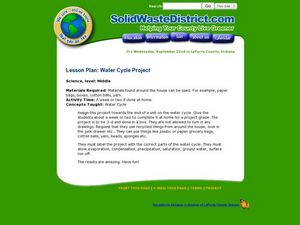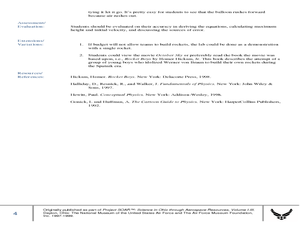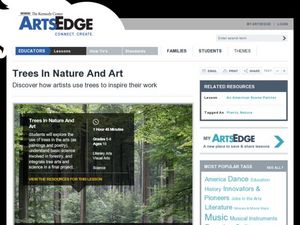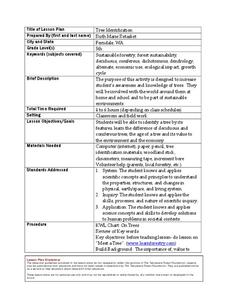Curated OER
Math, Chemistry, and Food
Learners explore the effects of chemical reactions when cooking. Using the Internet, they research enzymes and then mix jello. They examine their results and test enzyme activity by adding pineapple to the jello. Finally, they test...
Curated OER
Adrenoleukodystrophy (ALD):A Case Study Using the Film
Students study the genetic disorder Adrenoleukodystrophy (ALD) by viewing the film "Lorenzo's Oil". They complete a summary of the movie and answer questions while viewing the movie. Extensions activities also included.
Curated OER
Classroom Science Fair Project
Students explore the skills and information needed to complete a science fair project. They follow guidelines to create an document their science fair project.
Curated OER
What Kind of Insect is That?
Fifth graders characterize insects and classify insects according to the Linnaean system. They use hand lenses or microscopes to examine insect body parts.
Curated OER
Living and Nonliving
Students use their senses to record and collect data. In How Do I Classify Things in My World?, students practice classifying objects as living or nonliving. In Is it Real Or Pretend?, students group objects as real or pretend. In What...
Curated OER
Biology In Elementary Schools
Young scholars classify animals into six major animal groups and describe the characteristics of the animals found within each group. In this living and non-living animals activity, students observe a variety of animals, both...
Curated OER
Memory/Physiology Lab Activity
Young scholars investigate the nervous system and how physical distractions influence mental performance. They work in pairs as a researcher and subject and memorize a series of words with no distractions. After repeating the list of...
Curated OER
Comprehension of Word Problems
Third graders explore math functions by completing a worksheet in class. In this word problem solving lesson, 3rd graders read a book titled Counting on Frank by Rod Clement and utilize the information in the story to answer study...
Curated OER
Time-Lapsed Observations
Students explore timed observations for science investigations. They record ideas on a chart related to a classroom closed terrarium. They repeat their observations for several days and time observations for changing shadows during the...
Curated OER
Water Cycle Project
Students complete a water cycle project. In this Earth science lesson, students use recycled objects from around their homes to illustrate the water cycle. Students illustrate evaporation, condensation, precipitation, saturation, ground...
Curated OER
Catalase Enzyme
Students design and conduct an experiment to test their ideas about how to speed up or slow down the rate of an enzyme-catalyzed reaction. They have access to an array of physical and chemical factors that might influence enzyme...
Curated OER
Snell's Law
Learners determine whether the index of refraction of sample of Corn Syrup meets Federal standards. This task assess students' abilities to explain the procedures for investigation, plan for recording and organizing observations and...
Curated OER
Rockets: Kinematics or Energy?
High schoolers construct model rockets, measure and record the height of the launch. In this creative lesson plan students use different methods to calculate velocity and height data from their launched rockets.
Curated OER
Who's New in the Deep Sea?
Students examine the methods and technology that scientists use to study the deep sea and other remote environments. For this ocean habitats lesson students make observations about organisms from video clips, generate questions and...
Curated OER
Food For Keeps
Students investigate the concept of food preservation. They use the internet to conduct research, specifically the methods of processing the students' favorite foods. They are introduced to the project using realia like beef jerky and...
Curated OER
Eratosthenes And Radius of the Earth
Students calculate the radius of the earth. They use the method and data suggested by Eratosthenes. They investigate the interrelationships among mass, distance, force, and time through experimental processes.
Curated OER
Trees In Nature And Art
Students study the use of trees in art. In this investigative lesson students create art using leaf rubbings and develop a classification method for trees.
Curated OER
Science Inquiry Lesson: Mapping Project
Students explore the methods of creating maps. They create a map of Animas River Park using a compass and measuring tape, develop a single map from the team map sections, and devise another map of the Animas River Park using a GPS unit.
Curated OER
Tree Identification
Students list four ways to identify trees. In this tree identification instructional activity, students use tree identification techniques such as leafs, bark, wood grain, soil type, and climate to create tables and graphs.
Curated OER
Half Life Lab
Seventh graders model radioactive decay using pennies, collect data from their model, apply scientific visualization techniques to their data and create animated models explaining the concept of radioactive half-life.
Curated OER
Fossil Fuels, Who Needs Them
Ninth graders explore how electricity is created and distributed through alternative production methods. Students participate in hands-on activities, research, lecture based instruction, and CD ROM resources.
Curated OER
Science: Handwritten Personality
Learners watch an episode of "Frontiers" and discover the scientific basis for handwriting analysis. In the video, they discover how size, shape, and slant of handwriting suggest personality traits. After a discussion, students offer...
Curated OER
Deep Freeze
Students practice various sampling methods for retrieving data under water, ice, and soil. They use the sample material to make temperature measurements, chart contents, and draw their own conclusions as to what is happening in the...
Curated OER
Concentration and Reaction Rates
Students investigate how varying the concentrations, volumes, and other factors affects reaction rates. Students design and conduct investigations to obtain data used to create graphs of an uncatalyzed reaction vs. a catalyzed reaction....























